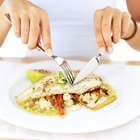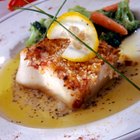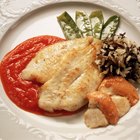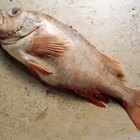
Digital Vision./Digital Vision/Getty Images
Many chefs will agree that the tastiest, most tender part of any fish is the cheek. These delicious little morsels are easy to prepare and can be eaten by themselves or as part of a recipe. Salmon cheeks may be difficult to find and can be fairly expensive, so consider buying a salmon head or heads, which are typically far more fiscally friendly. Plus, you can easily remove the cheeks before using the rest of the head for roasting or making stock.
Removing the Cheeks From the Head
Place the salmon head on a cutting board and gently feel along the fish's cheek to find the bowl-shaped cheek.
Cut the cheek off by making a C-shaped flap beginning near the eye and ending at the mouth. After making the flap, lift it with one hand as you carefully cut under the cheek muscle as deeply as possible.
Lift the flap that you just made and finish cutting the cheek from the salmon's head before repeating on the other side. Once you've remove both cheeks, cut the skin off of each cheek.
Sauteing Salmon Cheeks
Keep the preparation methods simple to allow the flavor and texture of the salmon cheek to shine. Dredge each cheek lightly in flour and heat a pan over medium or medium-high heat.
Melt butter or heat cooking oil in the pan before adding the salmon cheeks to the pan. Cook the cheeks until the flesh is opaque, flipping them halfway through.
Remove the cheeks from the pan and serve them with lemon wedges and herbs such as fresh, chopped parsley if desired.
Boiling Salmon Cheeks
Grab a medium or large pot, fill it with water and put it on the stove. Turn the burner on to high or medium-high and bring the water to a rolling boil.
Salt the water with a a tablespoon of salt, if desired, before adding the salmon heads to the water. Bring it back to a boil and reduce the heat to medium or medium-high.
Boil the salmon heads for roughly 10 minutes, or until the flesh is very tender. Remove the heads from the pot and let them rest until they are cool enough to handle.
Lay each head on its side and lift the cheek gill with a fork. The salmon cheek, which should be opaque in color, should be very tender and easy to scoop right out of the fish head. Top with butter and fresh herbs or seasonings to taste.
Related Articles
How to Cook Chilean Sea Bass Cheeks

How to Clean a Sucker Fish

How to Cook Fresh Brook Trout

How to Cook Trigger Fish

How to Cook Grunt Fish

How to Fillet a Goliath Grouper

How to Clean Mullet

How to Cook a Fresh Perch

How to Grill a Cod Fish

How to Pan Sear Sea Bass

How to Clean Tilapia

How to Fillet a Black Cod Fish

How to Cook Redfish on a Grill

How to Cook Flathead
How to Cook Seasoned Keta Salmon

Easy Way to Debone a Trout

How to Cook a Bullhead Fish

How to Cook a Pork Loin Fillet
How to Cook Atlantic Salmon Fillets

How to Cook Parrotfish
References
- Beard on Food: the Best Recipes and Kitchen Wisdom from the Dean of American Cooking; James Beard
- The Fishmonger's Apprentice: The Expert's Guide to Selecting, Preparing and Cooking A World of Seafood, Taught by the Masters; Aliza Green
- The Catch: Sea-to-Table Recipes, Stories and Secrets; Ben Sargent
- Hunter Angler Gardener Cook: Six Days of Salmon
- Native Tech: Skok Salmon Cheeks
- Cooking with Stellaaa: Garlic and Butter Broiled Salmon Heads
- James Beard's New Fish Cookery; James Beard
Tips
- Use the microwave if you don't feel like taking the time for boiling the heads. Microwave each salmon head for about 4 to 8 minutes on high. Take the head out of the microwave, lift the cheek gill and remove the salmon cheek from the head.
- Add your tender salmon cheeks to another recipe. For example, you can cook up a decadent omelet by adding the cheeks, along with whatever other ingredients you like, such as bacon, vegetables and seasonings.
Writer Bio
Caryn Anderson combines extensive behind-the-scenes writing experience with her passion for all things food, fashion, garden and travel. Bitten by the travel bug at the age of 15 after a trip to Europe, Anderson fostered her love of style and fashion while living in New York City and earning her degree at New York University.
Photo Credits
Digital Vision./Digital Vision/Getty Images